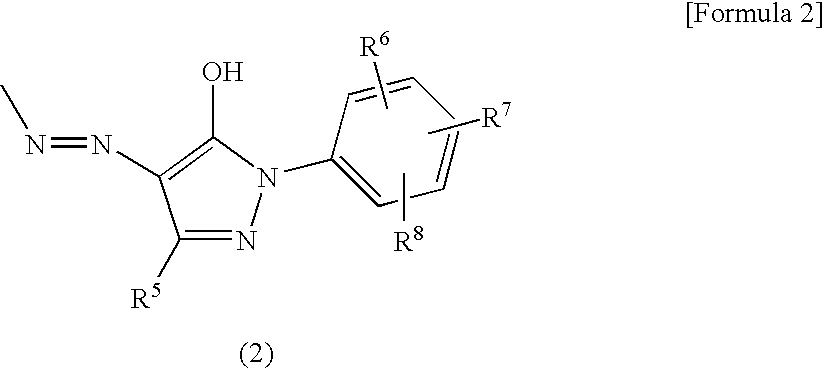Azo compound, ink composition, and colored object
a technology of ink composition and compound, applied in the field of azo compound, ink composition, colored object, can solve the problems of not providing product sufficiently satisfying market needs, poor color rendering, and improvement of ozone gas fastness, and achieve excellent water-solubility, excellent stability in recording solution storage, and excellent filtration property of membrane filter during production steps.
- Summary
- Abstract
- Description
- Claims
- Application Information
AI Technical Summary
Benefits of technology
Problems solved by technology
Method used
Image
Examples
example 1
[0125](1) 20.1 parts of 2-amino-5-naphthol-1,7-disulfonic acid and 12.6 parts of p-toluenesulfonylchloride were subjected to reaction at pH 8.0 to 8.5, at 70° C. for 1 hour, followed by salting out in acidic condition and filtering to obtain the compound of Formula (17), and 28.4 parts of the compound was then dissolved in 300 parts of water while adjusting the pH at 6.0 to 8.0 with sodium carbonate, and after adding 18.7 parts of 35% hydrochloric acid, diazotized by the addition of 10.7 parts of 40% aqueous solution of sodium nitrite, at 0 to 5° C.
[0126]
[0127]To this diazo suspension was added a solution of 19.1 parts of 4-amino-5-hydroxynaphthalene-1,7-disulfonic acid suspended in 200 parts of water, followed by stirring for 12 hours while maintaining the pH of the solution at 2.4 to 2.8 with sodium carbonate, at 10 to 20° C. After stirring, adjusting the pH at 7.0 to 8.5 with sodium carbonate to dissolve, a solution containing a monoazo compound of Formula (18) was obtained.
[0128...
example 2
[0139]In the same way as in (3) of Example 1 except that 11.5 parts of 2-amino-4-acetylaminobenzenesulfonic acid was used instead of 11.5 parts of 2-amino-5-acetylaminobenzenesulfonic acid in the process of (3) in Example 1, a wet cake containing a monoazo compound of Formula (24) was obtained.
[0140]
[0141]The above obtained wet cake containing a compound of formula (24) was dissolved in 300 parts of water, while adjusting the pH at 6.0 to 8.0 with sodium hydroxide. To the solution obtained, 19.8 parts of 35% hydrochloric acid and 9.2 parts of 40% aqueous solution of sodium nitrite was added at 10 to 20° C. for diazotization. This diazo suspension was added dropwise to a solution where a wet cake containing a compound of Formula (20) which was obtained in the same method as in the processes of (1) and (2) in Example 1 was dissolved in 400 parts of water, while maintaining the pH value of the solution at 8.0 to 9.0 with sodium carbonate, at 10 to 25° C. After completion of the dropwis...
example 3
[0143]In the same way as in Example 1 except that 15.5 parts of 2-amino-5-acetylaminobenzene-1,4-sulfonic acid was used instead of 11.5 parts of 2-amino-5-acetylaminobenzenesulfonic acid in the process of (3) in Example 1, 54.0 parts of an azo compound of Formula (26) (a compound No. 9 in Table 3) was obtained. In this connection, 2-amino-5-acetylaminobenzene-1,4-disulfonic acid can be obtained easily by reaction of 2,5-diaminobenzene-1,4-disulfonic acid with acetic anhydride. The maximum absorption wavelength of this compound in water was 597 nm, and solubility in water (ammonia alkali) by filter paper spot was no less than 100 g / l.
[0144]
PUM
| Property | Measurement | Unit |
|---|---|---|
| temperature | aaaaa | aaaaa |
| temperature | aaaaa | aaaaa |
| pH | aaaaa | aaaaa |
Abstract
Description
Claims
Application Information
 Login to View More
Login to View More - R&D
- Intellectual Property
- Life Sciences
- Materials
- Tech Scout
- Unparalleled Data Quality
- Higher Quality Content
- 60% Fewer Hallucinations
Browse by: Latest US Patents, China's latest patents, Technical Efficacy Thesaurus, Application Domain, Technology Topic, Popular Technical Reports.
© 2025 PatSnap. All rights reserved.Legal|Privacy policy|Modern Slavery Act Transparency Statement|Sitemap|About US| Contact US: help@patsnap.com



